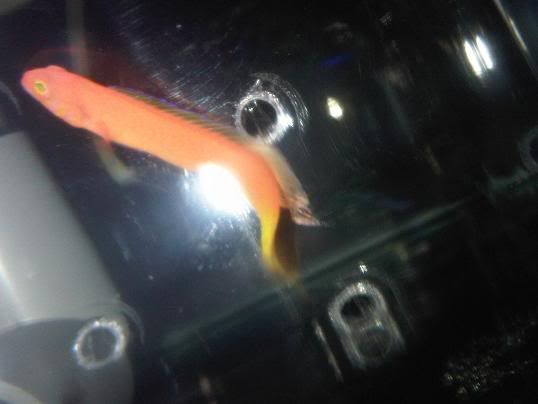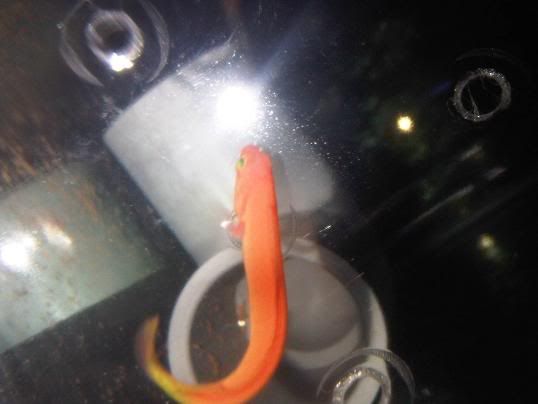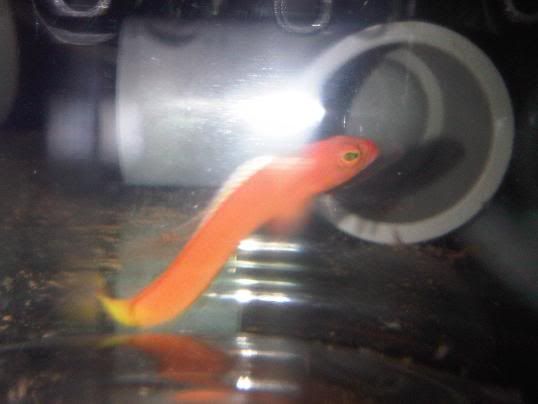-
Posts
94 -
Joined
-
Last visited
-
Days Won
1
Content Type
Profiles
Forums
Gallery
Posts posted by Tony Gill
-
-
Hi Dr Gill,
It's awesome to have you here! An expert on board to clear our doubts and myths in dottybacks!
This collare pic that i attached from fishbase looks quite different from those i posted. In Jack Randall picture below it is more brownish and lack a yellow tail.
Whereas in this pic i below i posted earlier, the fish appears more pinkish and has a translucent yellow tail.
Since you said both are the same species, which is collare, does collare has two color forms? One brown one pink?
Or is it just the photo quality that caused the color difference?
The sort of differences you point out are within the range of variation I've found in other Pseudoplesiops. Aside from your photos, the only others I have are from Flores and Misool (the latter in Gerry Allen and Mark Erdmann's Reef Fishes of the East Indies). There is always the possibility that your fish actually represents a different (thus new) species, and the distribution of other pseudochromid species would lend support to that possibility. I would need to examine specimens (and perhaps more photos) before I could make judgement on that.
-
The other thing is the number of bands on the body. Although these are indistinct in the photos, it looks like it has the characteristic 8-10 narrow bands of P. poweri rather than the 4-5 broad bands of P. meleagris.
-
I agree that it looks more like P. poweri, particularly in the head markings. This website has good photos of all Paraplesiops species, including photos of juveniles of several: http://www.fishesofaustralia.net.au/Home/genus/1097.
Tony
-
The goby looks like Pseudogobius javanicus.
Tony
-
It's a bit hard to tell from your photo, but I think it's Amblyeleotris gymnocephala.
Tony
-
Looks like Drombus triangularis to me.
Tony
-
Labracinus cyclophthalmus. This colour form is often referred to as L. melanotaenia, but I placed the latter in synonymy with L. cyclophthalmus in my 2004 revision of the Pseudochrominae. Basically I found there was considerable variation in the degree of striping in individuals from a given locality, from some with no stripes, to stripes on each scale row or stripes on alternative scale rows (as in the L. melanotaenia form). I found similar variation in the Western Australian species, L. lineatus. However, I am now revisiting the issue of whether L. cyclophthalmus is a single species or a complex of similar species, incorporating molecular sequence data and more comprehensive studies of live coloration.
Tony
-
It's a juvenile Scolopsis margaritifera - pearly monocle bream.
-
The masudai died of a viral infection. Brought down to ML but the condition was so serious and the fish could not be saved. One of the most impressive fish i've kept, RIP.
On a brighter note, here's some new nano fishes i acquired recently:
1) Lubbockichthys multisquamatus (Thanks lemon for letting me have the fish)
2) Serranus chionaraia (This guy is small, only 1", a very rare size)
They are starting to stick together with my pseudoplesiops rosae. I call them the happy "three" friends:
The fish you have identified as Pseudoplesiops rosae is actually a species of Lubbockichthys - and quite possibly the same as your L. "multisquamatus" individual. I am still in the process of sorting out species in this genus, but many are difficult to identify without x-rays to examine skeletal characters. Real Pseudoplesiops rosae is a very different fish ... grows to around 3cm with large scales. There are photos of it here: http://research.kahaku.go.jp/zoology/Fishes_of_Andaman_Sea/contents/pseudochromidae/03.html
Thanks,
Tony
-



This is what dottyback? id pls.... is it rare??
This is a species of Lubbockichthys, possibly one of the new ones I'm working on from Cebu. Lubbockichthys species are difficult to tell apart ... I have been working on the genus for a couple of decades and still need x-rays to identify some of the species! There is a lot of confusion at the moment about these species, as several are often identified as Pseudoplesiops rosae. This error appears to have originated from a couple of guide books published by Rudie Kuiter, but has been perpetuated in the aquarium hobby. Real P. rosae is a very different fish: very small (around 3 cm) with large scales. There are photos of it here: http://research.kahaku.go.jp/zoology/Fishes_of_Andaman_Sea/contents/pseudochromidae/03.htmlhttp://research.kahaku.go.jp/zoology/Fishes_of_Andaman_Sea/contents/pseudochromidae/03.html The coloration can be very variable, ranging from green or brown to bright yellow or bright red. The dark marking behind in the eye is usually present, but is sometimes difficult to see.
Thanks,
Tony
-
Yuri, Digi, and anyone else.
i have recently been sent a picture of an unknown dottyback for ID. it has however, an unsual tail. it is slightly rhomboidal in shape. the only dottyback i know with a diamond tail is Ogilbyna verlifera, the sailfin dottyback. however there are very few images of it online and it is found in australia. the males have very long diamond tails like lanceolatus fairy wrasse.
this dottyback is found in cebu, philippines.
i suspected it was afterall, O. verlifera, but a female. with an under devleoped tail and subdued coloration.
here is a video from shutterstock with an identical fish swimming in this time, indonesia. it is labelled as O. velifera female. is this accurate, i don't know. i have e-mailed dottyback authority Dr. Anthony Gill and hopefully we'll get a reply. video here -> http://footage.shutterstock.com/clip-2534186-stock-footage-female-adult-sailfin-dottyback-ogilbyina-velifera-swimming-underwater-in-indonesia.html
so what do you think?
The fish in the photo appears to be a new species closely related to Pseudochromis reticulatus (from north-western Australia), P. pictus (SE Indonesia) and P. jace (NE Indonesia (West Papua)). I am currently working on another new species in the group (which is characterised by, among other things, the unusual caudal-fin shape) from NE Indonesia. I have some juvenile specimens from Cebu that may be the same as species in the photo here, but it would be good to have larger specimens for study. The pseudochromid in the footage from Indonesia is P. pictus.
Thanks, Tony
-
Three amazing deepwater fishes photographed in Cebu, Mactan Island.
Deepwater Chromis Brevirostris
Deepwater Tryssogobius Sp
Deepwater Pseudochromis Sp. (50m and deeper)
Great to see these photos. This is Pseudoplesiops collare, a species I described over 20 years ago with Jack Randall and Alasdair Edwards. (It was actually the first fish species I ever named.) This species is very rare in museum collections ... I am aware of only four specimens. I'd be very interested to hear more details on where they were photographed, etc., as I am currently working up a major paper revising the genus Pseudoplesiops. Thanks, Tony
-
It looks like Halichoeres marginatus to me too.
Tony
-
Looks like a Tomiyamichthys species.
Tony
-
It's not a goby, but a blenny of the genus Omobranchus. I'm not sure of the species though ... possibly O. germaini.
Tony



Please help ID
in New to the Marine Aquaria Hobby
Posted
I think it's N. cyanomos rather than N. azysron. The latter species doesn't have dark edges on the caudal fin.
Tony